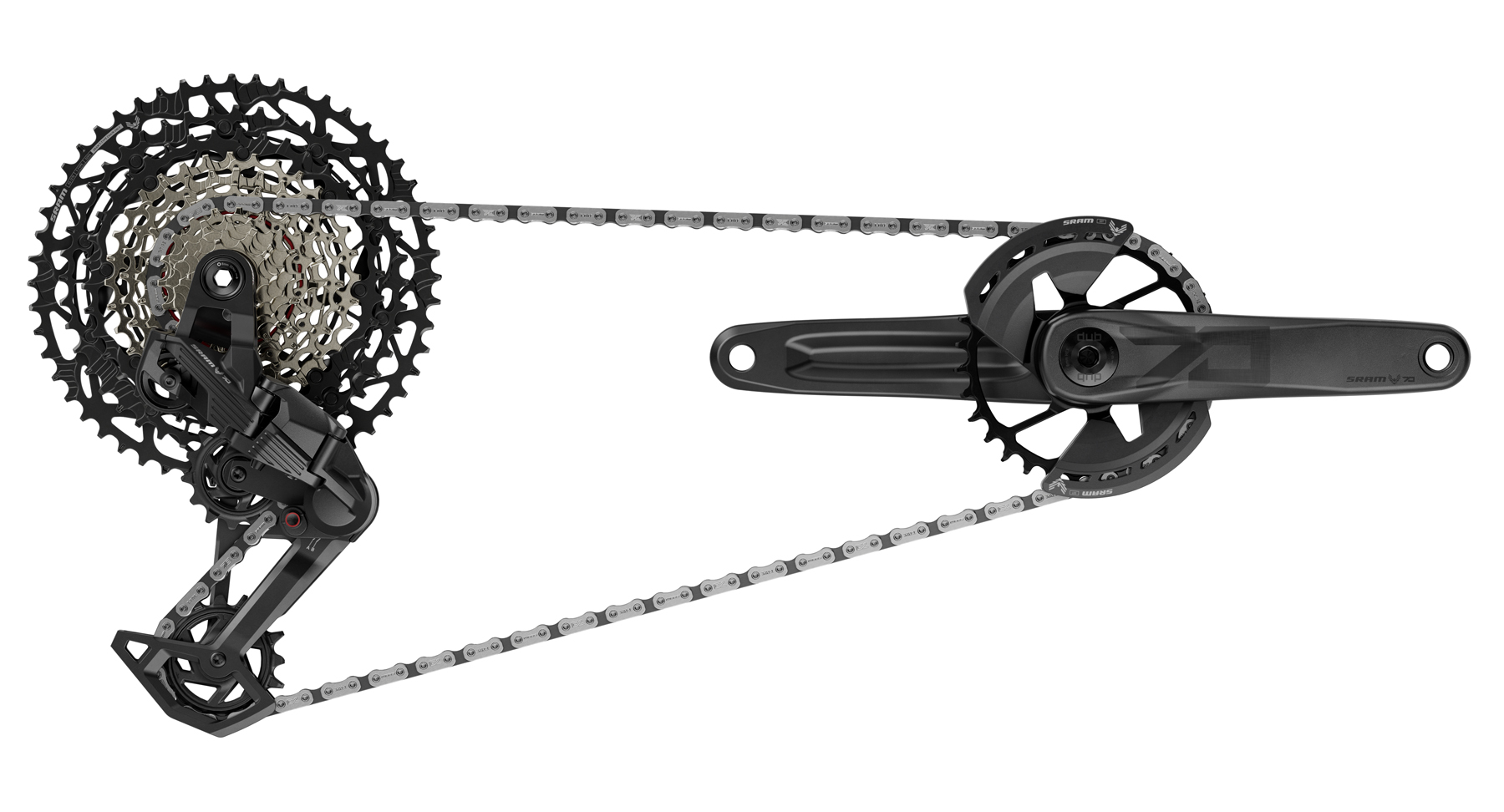
Intro
Ever since SRAM’s initial launch of their all-electronic Transmission (also known as T-Type) groupsets almost exactly two years ago, it’s been an open question if and when a mechanical cable-actuated version would arrive. Well, now it has, in two different tiers — Eagle 70 and 90. The higher-end Eagle 90 groupset is meant to be roughly GX-level in SRAM’s existing nomenclature (and shares some parts with the GX T-Type group, as we’ll get into below); the Eagle 70 group is a more affordable version, aimed primarily at OE sales on complete bikes.
We’ve spent a good bit of time on the Eagle 90 group already, and BLISTER+ Members and folks with our Digital Access Pass can check out our on-trail impressions so far. We’ll have a Full Review to come, but in the meantime, let’s dive into the design details of the new groups.
[A quick note on specs: we’ve listed measured weights for the parts we’ve gotten our hands on so far and SRAM’s published weights elsewhere; it’s stated clearly which is which. And on the pricing side, all EU/UK prices include VAT.]
Derailleurs
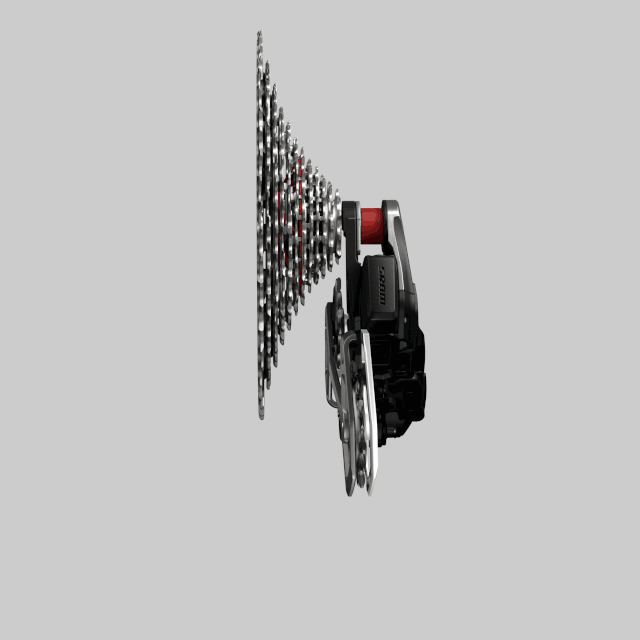
The main difference, of course, is that the Eagle 70 and 90 derailleurs are cable-actuated, forgoing the battery/motor/gearbox that drives the wireless AXS variants in favor of a conventional derailleur cable. The cable pull ratio used is, unfortunately, different from existing SRAM mechanical groupsets, so you need to use one of the new Eagle 70 or 90 shifters (more on those in a minute) in conjunction with the new derailleurs. That also means that there’s also no solution for folks who want to run a mechanical Transmission setup on a drop bar bike at this time.
As with the earlier Transmission variants, though, the new Eagle 70 and 90 parts are cross-compatible with other tiers of T-Type groups; if, for example, you want to pair an Eagle 90 shifter and derailleur with one of the higher-end cassettes/cranks/chains, that is an option.
In keeping with the electronic Transmission derailleurs, the Eagle 70 and 90 derailleurs don’t feature limit screws, instead relying on the direct interface between the hub endcap and the derailleur to control alignment. They also don’t feature a conventional B-tension screw, though that functionality is instead handled in the derailleur mounting process itself, just as it is with the electronic T-Type derailleurs. (Check out our First Look on those for a much more in-depth explanation.)
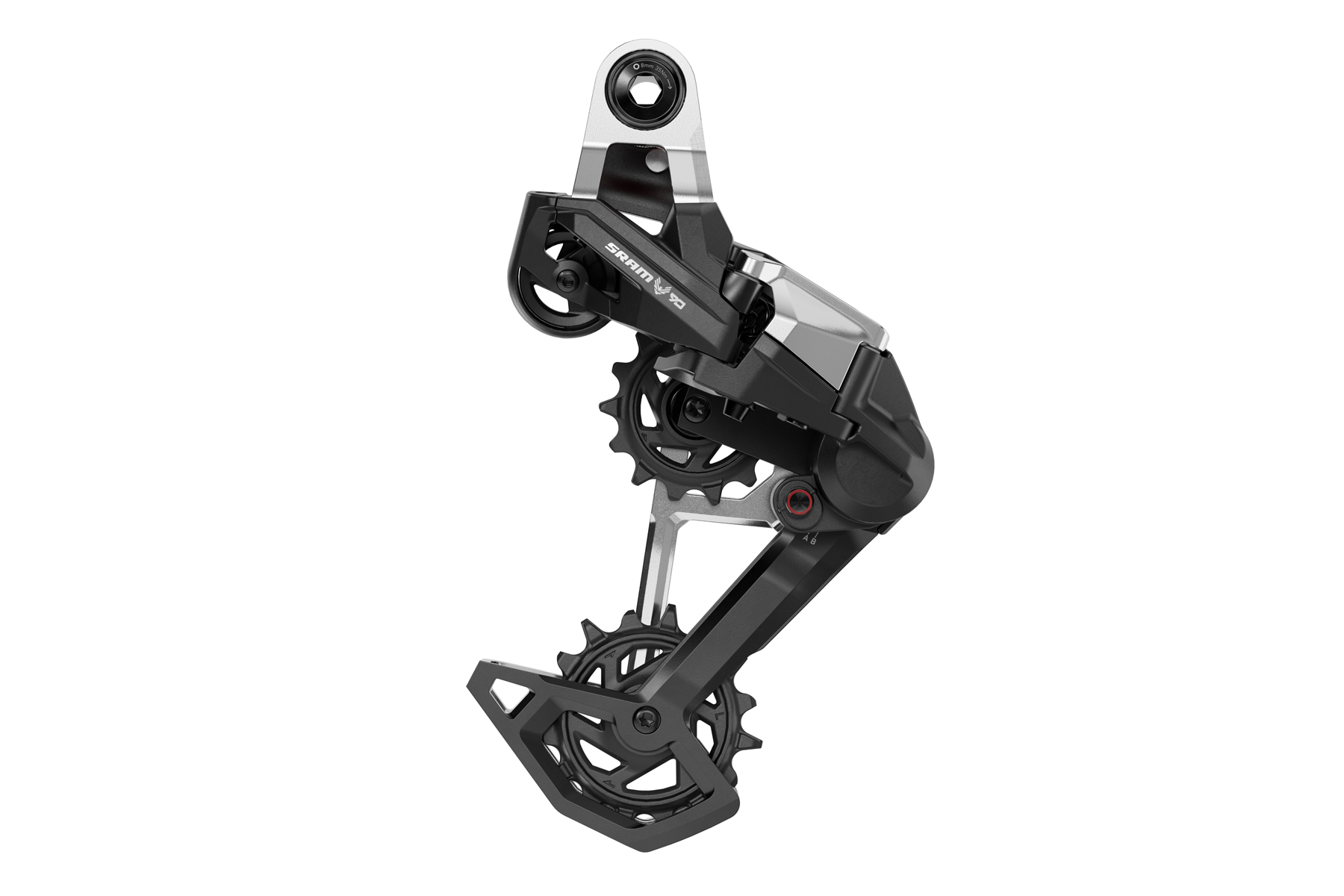
Eagle 90 Derailleur
- MSRP: $190 / €205 / £185
- Stated Weight: 395 g
- Blister's Measured Weight: 392 g

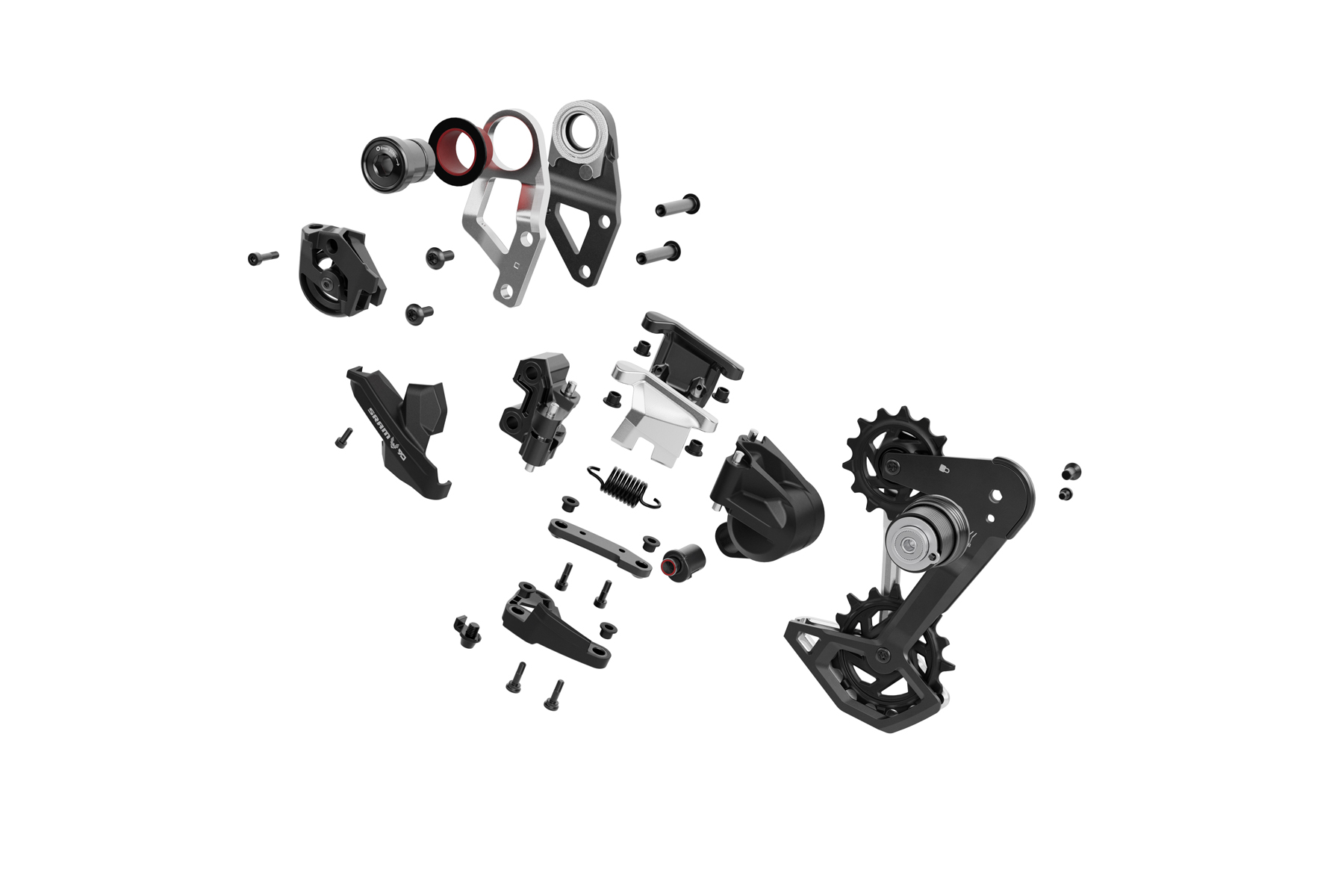
Eagle 70 Derailleur
- MSRP: $125 / €135 / £120
- Stated Weight: 415 g
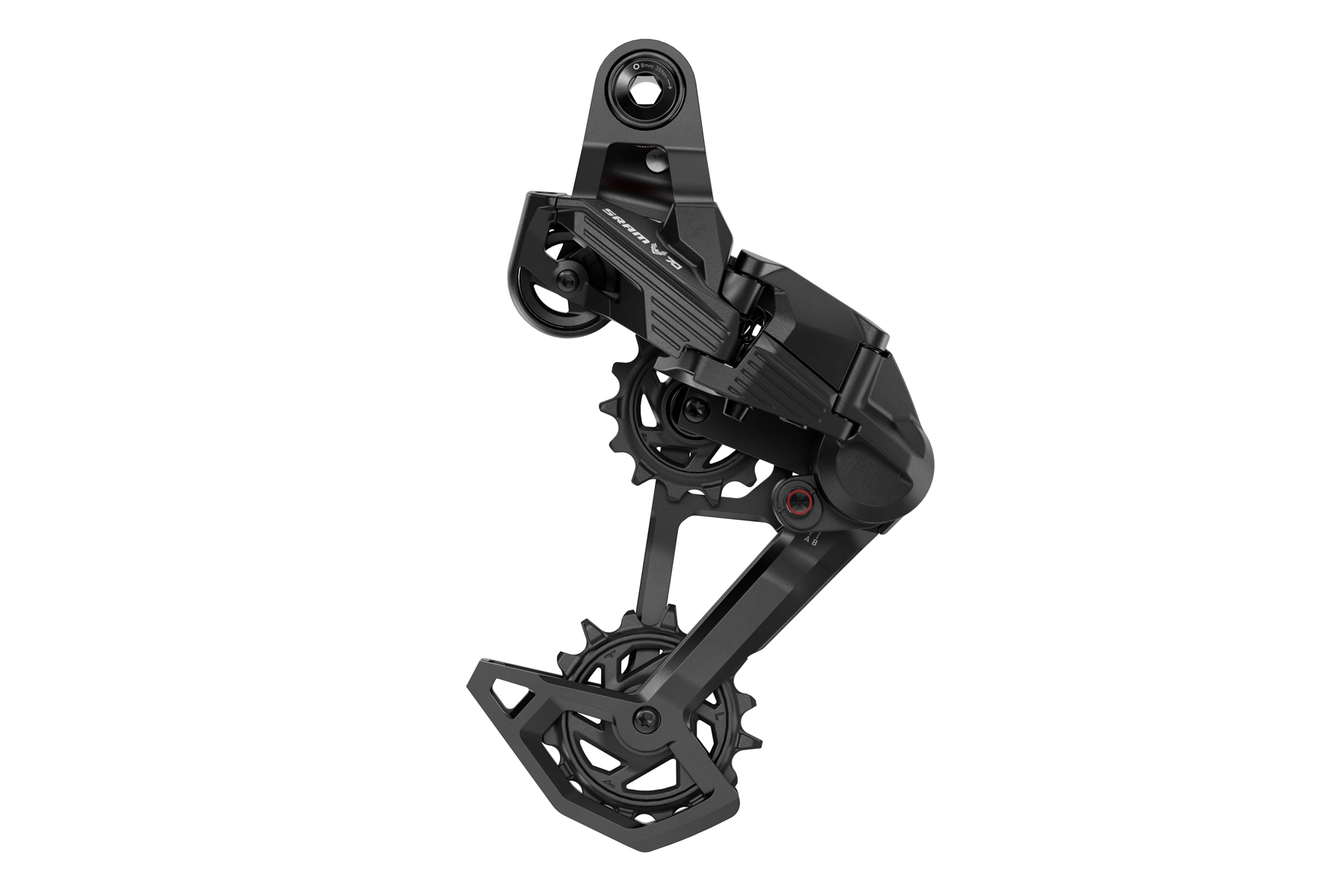
Shifters
The Eagle 70 and 90 shifters use a nearly identical form factor, with different materials used in key areas to create a more premium variant (Eagle 90) and a more affordable one (Eagle 70). The shape and positioning of the shift paddles are very similar to SRAM’s existing Eagle 12-speed shifters, though, again, the cable pull ratios are different, so the two aren’t cross-compatible. The Eagle 70 and 90 shifters feature a conventional barrel adjuster at the cable exit and route the shift housing parallel to the handlebar for a cleaner match with their Stealth brakes.
Both the Eagle 70 and 90 shifters are offered in two different versions — a single-click one for use on eMTBs and a double-click option that’s officially approved for use on unpowered bikes only. The only difference is that the single-click version has, well, a single click on the downshift paddle, requiring that you push and release it for each gear shift, while the double-click version can shift two gears with one sweep of the paddle.
Eagle 90 Shifter
- MSRP: $50 / €55 / £50
- Stated Weight: 135 g (w/ discrete clamp)
- Blister’s Measured Weight: 116 g (shifter only, w/o clamp)
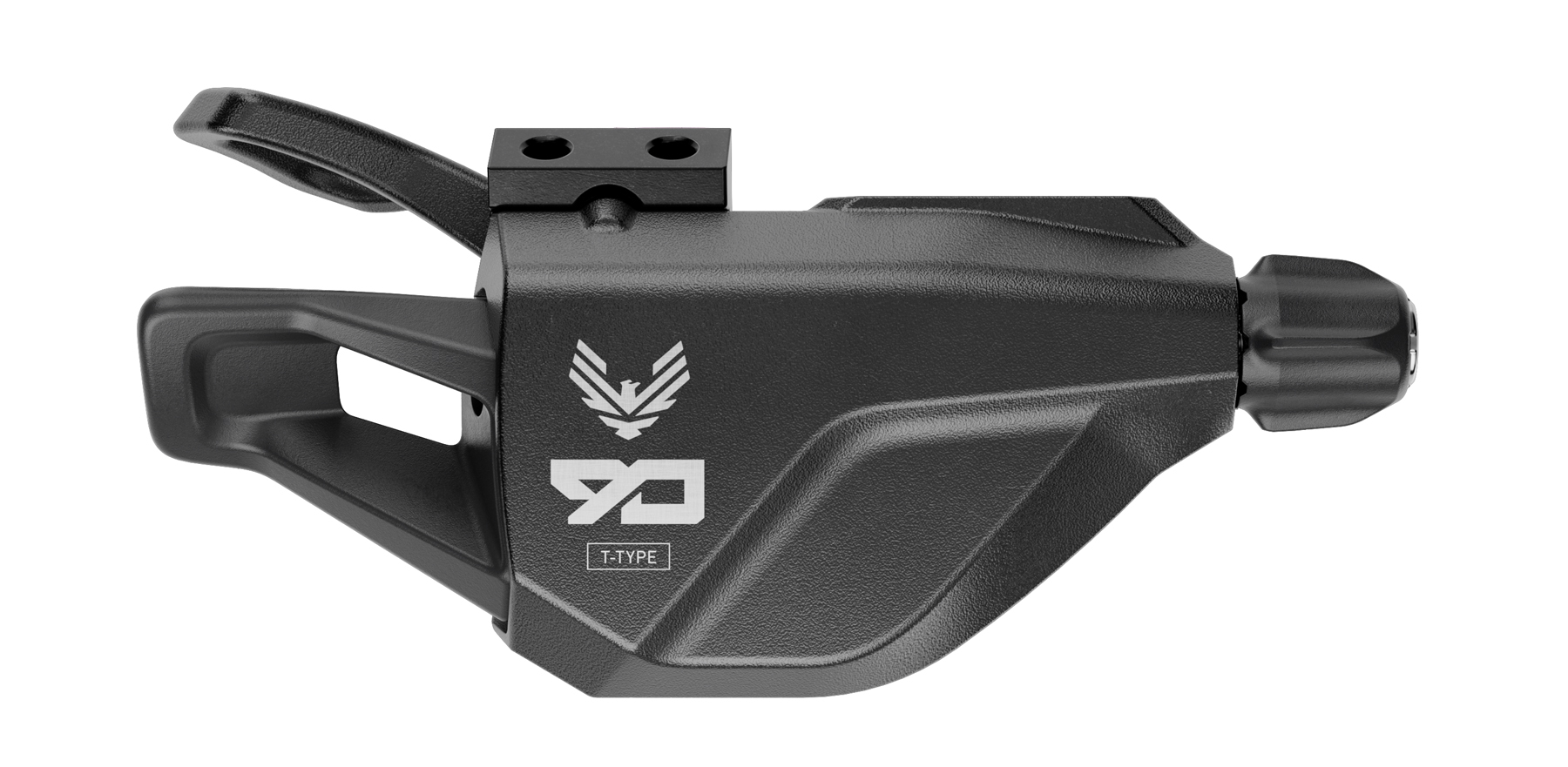
Eagle 70 Shifter
- MSRP: $30 / €35 / £30
- Stated Weight: 145 g
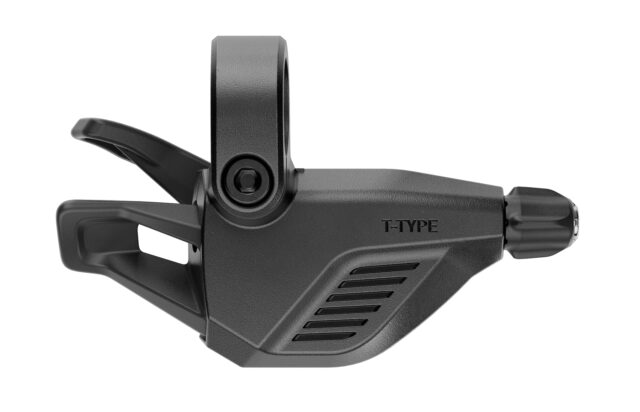
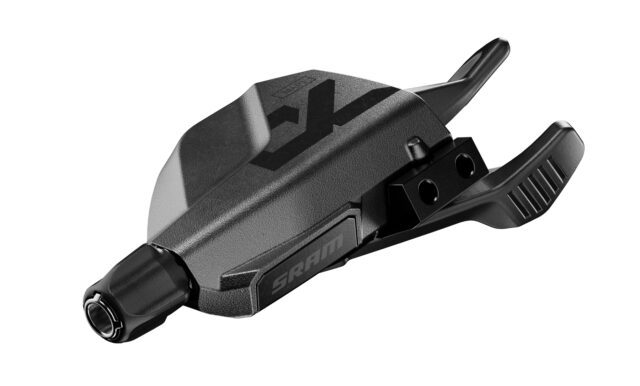
Cassettes
Eagle 90 Cassette
- MSRP: TBA
- Stated Weight: 445 g
- Blister’s Measured Weight: 444 g
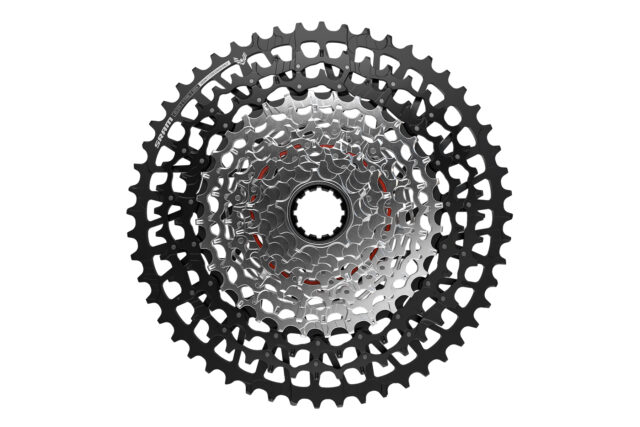
The Eagle 90 cassette is the same as the GX Transmission cassette, just with a different cosmetic finish. It uses SRAM’s typical XD driver and gets a 10-52 tooth range with the same gear steps as the other Transmission cassettes. The nine smallest cogs are nickel-plated steel; second and third gears are also steel, just with a black finish, and the largest cog is aluminum. The cassette is a one-piece unit, so individual gears or clusters of gears are not independently replaceable.
We don’t yet have official pricing for the Eagle 90 cassette, but the GX T-Type one retails for $250 / €300 / £270; we’d expect the Eagle 90 one to be similar.
Eagle 70 Cassette
- MSRP: TBA
- Stated Weight: 565 g
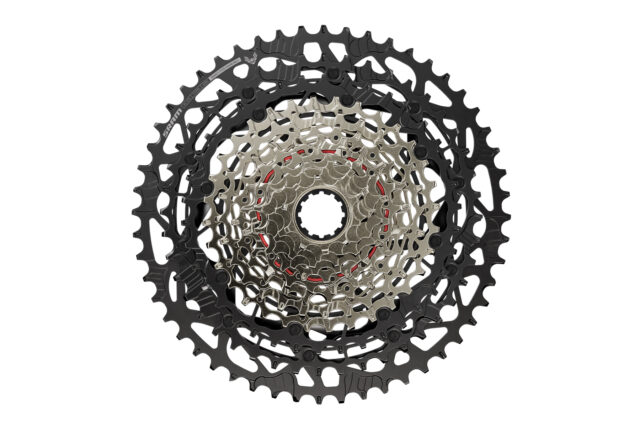
The Eagle 70 cassette is, in some ways, the biggest departure from the rest of the Transmission ecosystem — chiefly because it uses the longstanding splined Hyperglide (HG) hub interface rather than SRAM’s more typical XD one.
The switch in mounting standards makes it easier to build an inexpensive cassette — SRAM’s XD interface requires some more involved machining and fabrication. In contrast to most HG-compatible cassettes, though, the Eagle 70 uses a 10-tooth small cog, which is enabled by the fact that all of the T-Type cassettes are shifted farther outboard than standard, using the space opened up by forgoing a derailleur hanger. The 10-tooth cog is integrated into the lockring, so it’ll be interesting to see if that makes for some extra tight lockrings that are hard to remove, thanks to pedaling forces locking things down tightly. Granted, the small 10-tooth cog reduces the torque one can apply though pedaling by quite a bit compared to typical threaded freehub sizes.
Anyway, the Eagle 70 cassette is otherwise fully cross-compatible with other tiers of T-Type groupsets, including only being compatible with T-Type chains and Transmission derailleurs (at least without some finagling). Its more basic construction comes at a significant weight penalty (a stated 120 grams over the Eagle 90 cassette). We haven’t yet gotten pricing for the Eagle 70 cassette but will update this post when we find out.
Cranks
Eagle 90 Crankset
- MSRP (eMTB version): $100 / €110 / £95 (chainring not included)
- MSRP (standard version): $155 / €170 / £150 (includes steel chainring and two bash guards)
- Stated Weight (standard version): 825 g (including chainring and bash guards)
- Stated Weight (eMTB version): 490 g (arms only)
- Blister’s Measured Weight: 814 g (165 mm crank arms and spindle, 32t chainring, 2x bash guards)
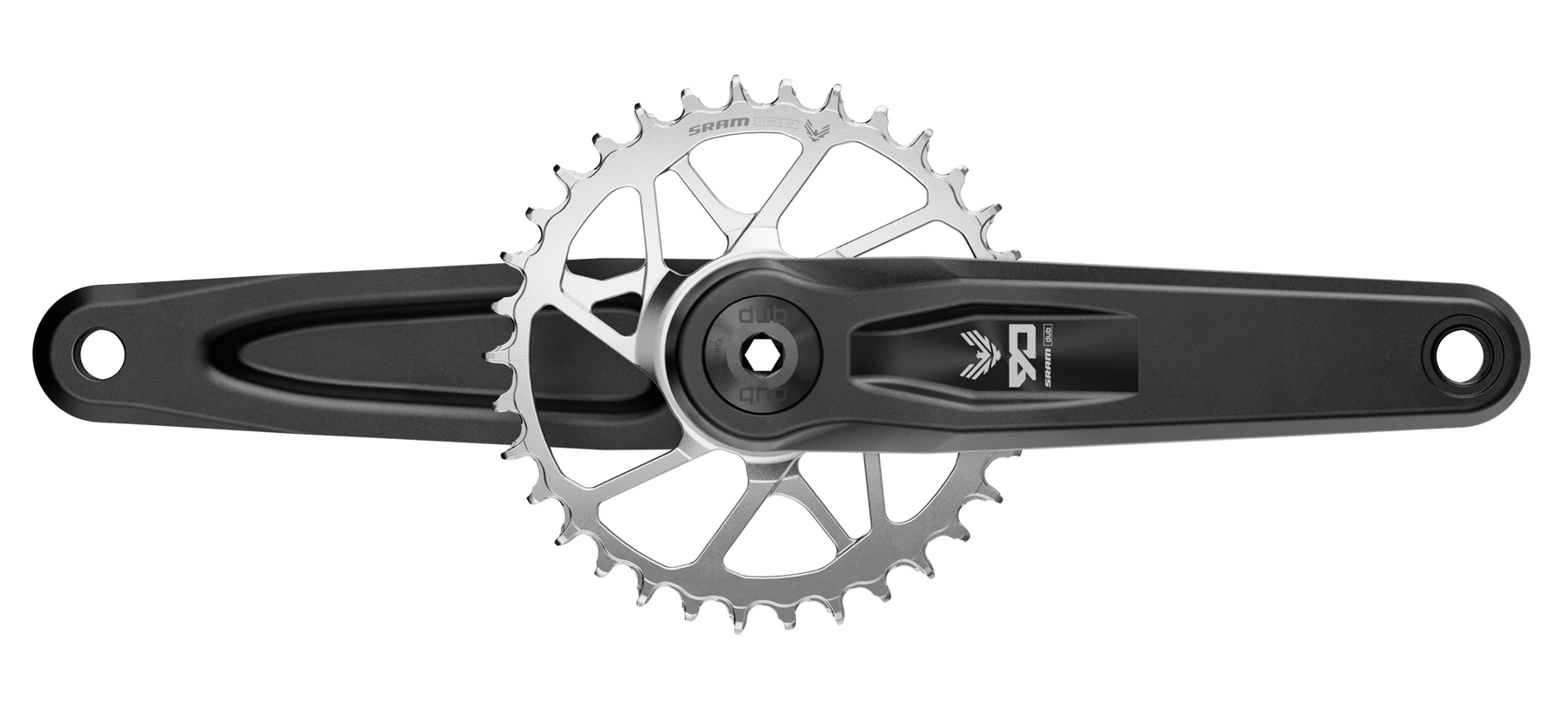
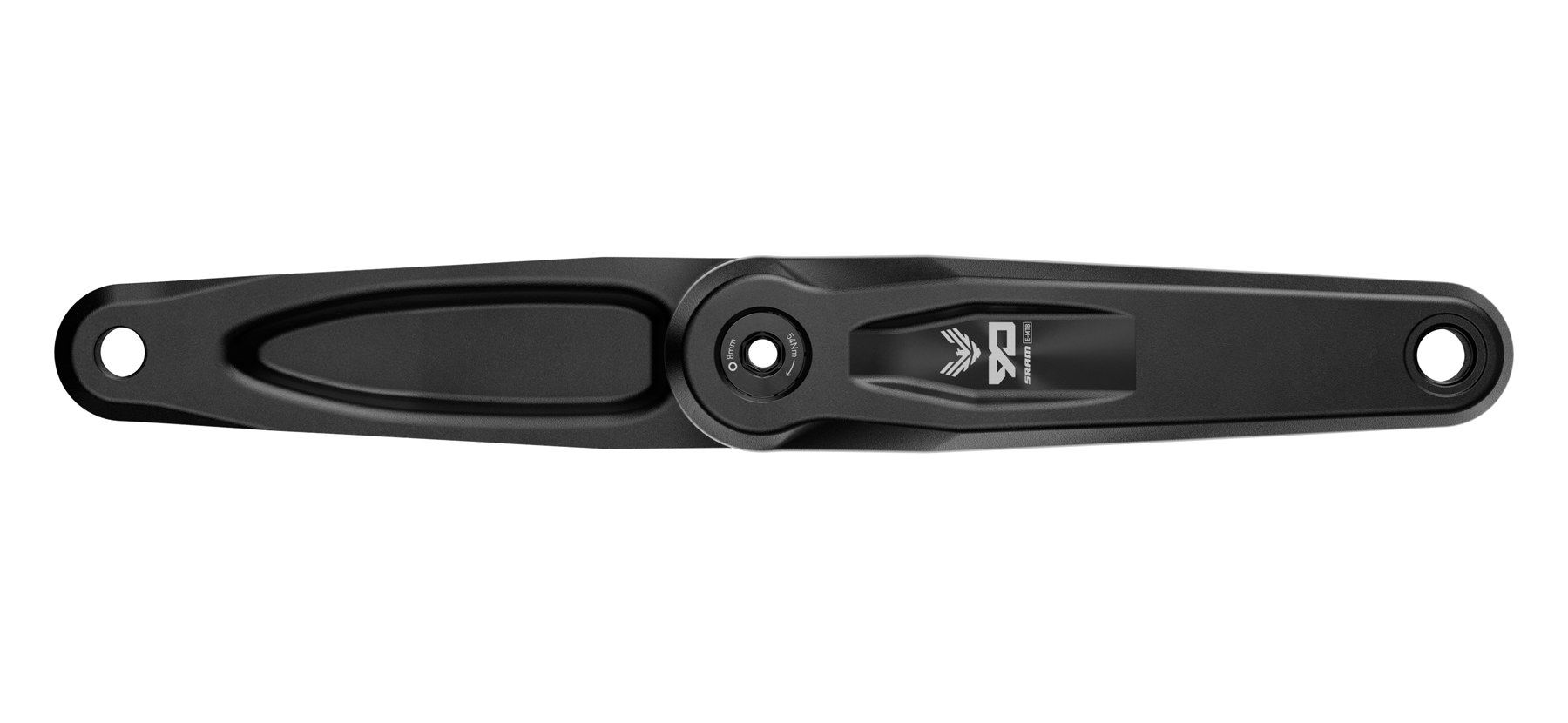
The standard Eagle 90 crankset is offered in 5 mm lengths from 155 to 175 mm while the eMTB versions start at 150 mm and go up to 170 mm, with 5 mm size increments for both versions. The arm forgings appear to be the same as those used in the GX T-Type crank, just with a black finish instead of gray, and the Eagle 90 cranks use the same eight-bolt chainring mounting interface as the existing Transmission cranks. That means you can run a spider-based power meter (sold separately) if you’re so inclined; there’s no spindle-mounted power meter option as there is on some of the higher-end Transmission cranks.
The main functional difference between the GX crank and the Eagle 90 one is that the latter comes with a stamped steel chainring instead of an aluminum one. The steel version is meant to be harder wearing at the expense of some weight, but you can run the aluminum chainring from one of the higher-end Transmission cranks on the Eagle 90 one, or put an Eagle 90-series steel chainring on another T-Type crank. The non-eMTB Eagle 90 cranks come with a 32-tooth chainring, though 30- and 34-tooth ones are also available.
The steel chainring is compatible with the same direct mount bashguards as the existing T-Type chainrings. And while the Eagle 90 crank uses the same self-extracting drive side arm attachment as SRAM’s other DUB cranks, the mounting bolt has been updated to use a 10 mm Allen wrench for the extracting ring, rather than the 4-pin spanner that’s been used previously.
Eagle 70 Crankset
- MSRP (eMTB version): $85 / €90 / £85 (chainring not included)
- MSRP (standard version): $90 / €100 / £90 (includes steel chainring and two bash guards)
- Stated Weight (standard version): 895 g (including chainring and bash guards)
- Stated Weight (eMTB version): 550 g (arms only)
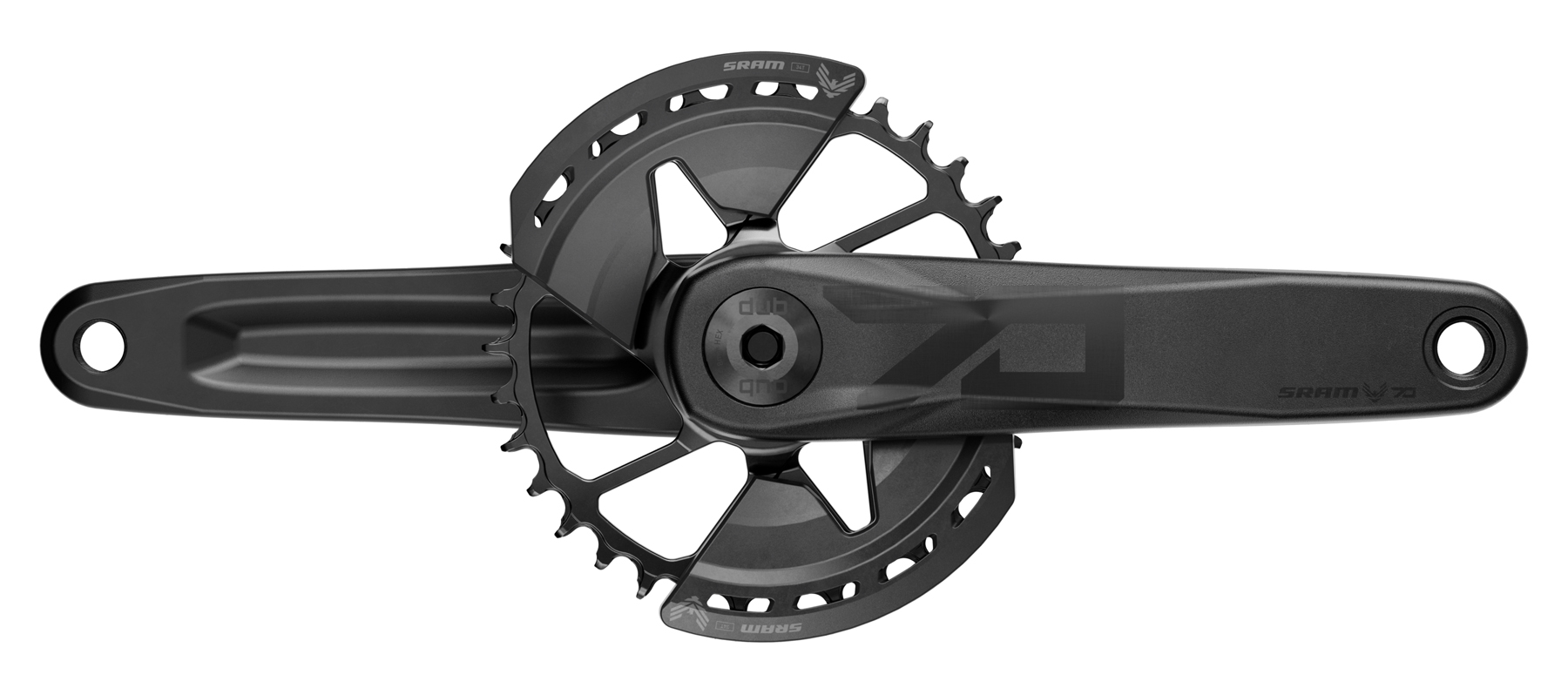
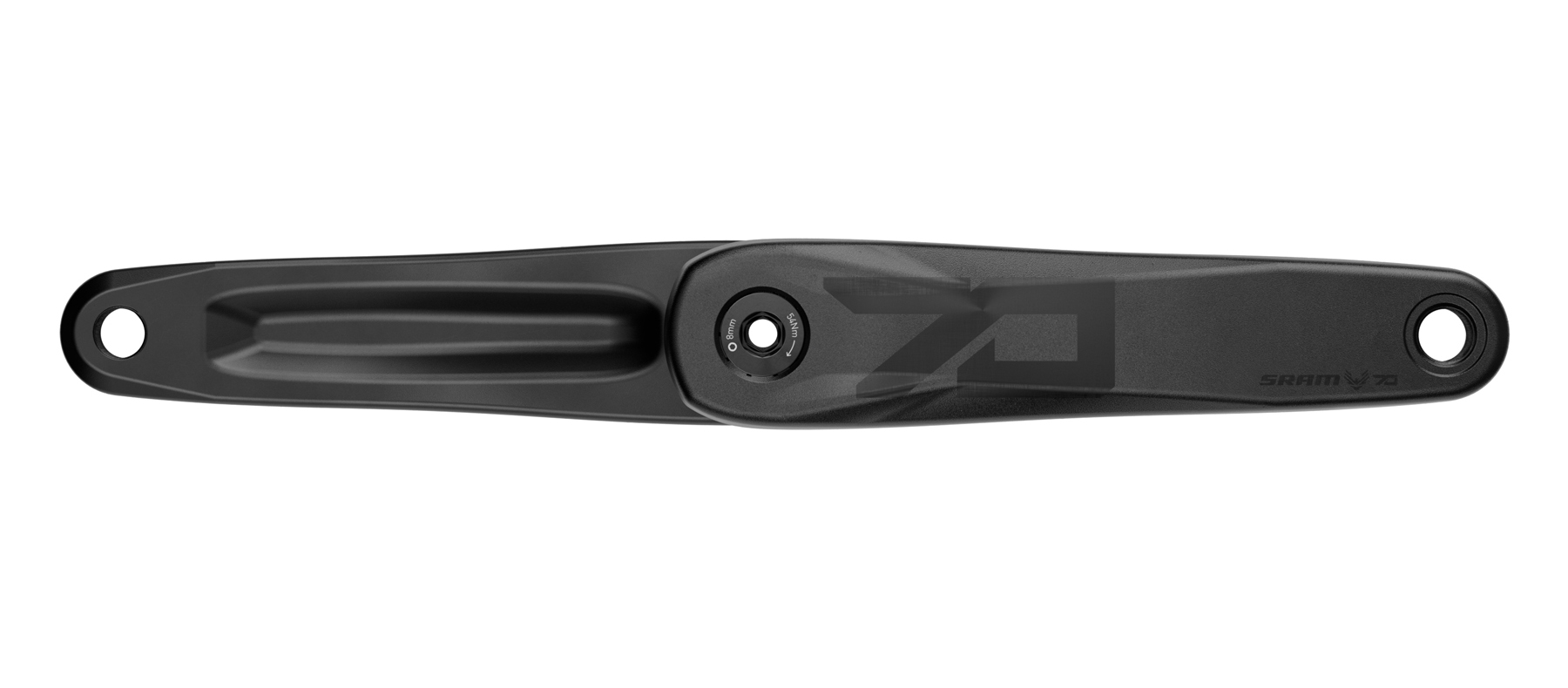
The Eagle 70 crank gets simpler arm forgings and uses SRAM’s three-bolt chainring mount that’s been used on their pre-Transmission MTB cranks that feature a direct mount chainring in place of the eight-bolt interface on the rest of the T-Type cranks. The standard version is offered in 165, 170, and 175 mm lengths, while the eMTB one comes in 160, 165, and 170 mm versions and in an ISIS mount only.
The new three-bolt chainring is also made from stamped steel, like the Eagle 90 one, and is offered in the same 30-, 32-, and 34-tooth versions. Like the 90-series chainring, it’s compatible with the same direct mount plastic bashguards used on the GX and X0 cranks (as well as the aluminum ones from the XX crank if you want to swap those in); two of the plastic ones are included with the standard crankset.
Chains
The default chain for the Eagle 90 groupset is the existing GX T-Type one, though, as with other tiers of Transmission parts, all the T-Type chains are cross-compatible, so it’s possible to run one of the other versions if you’re so inclined. Non T-Type chains are not compatible with any of the Transmission cassettes. The 70-series group gets a new, more basic chain that shares the Flat Top design of the other Transmission chain versions, just with more basic materials and construction. There’s not much of a weight penalty to the Eagle 70 chain (in fact, its stated weight of 270 g is 15 grams lighter than the GX one) but we’ve found higher-end versions of SRAM’s chains to be considerably more durable than the more affordable ones; the extent to which that’s true of the Eagle 70 chain remains to be seen but we’d bet on it wearing more quickly than some of the higher-end options. (The X0 T-Type chain has been remarkably hard-wearing in our experience.)
GX T-Type Chain
- MSRP: $50 / €60 / £55
- Stated Weight: 285 g
- Blister’s Measured Weight: 285 g

Eagle 70 Chain
- MSRP: $30 / €35 / £30.
- Stated Weight: 270 g

Groupsets
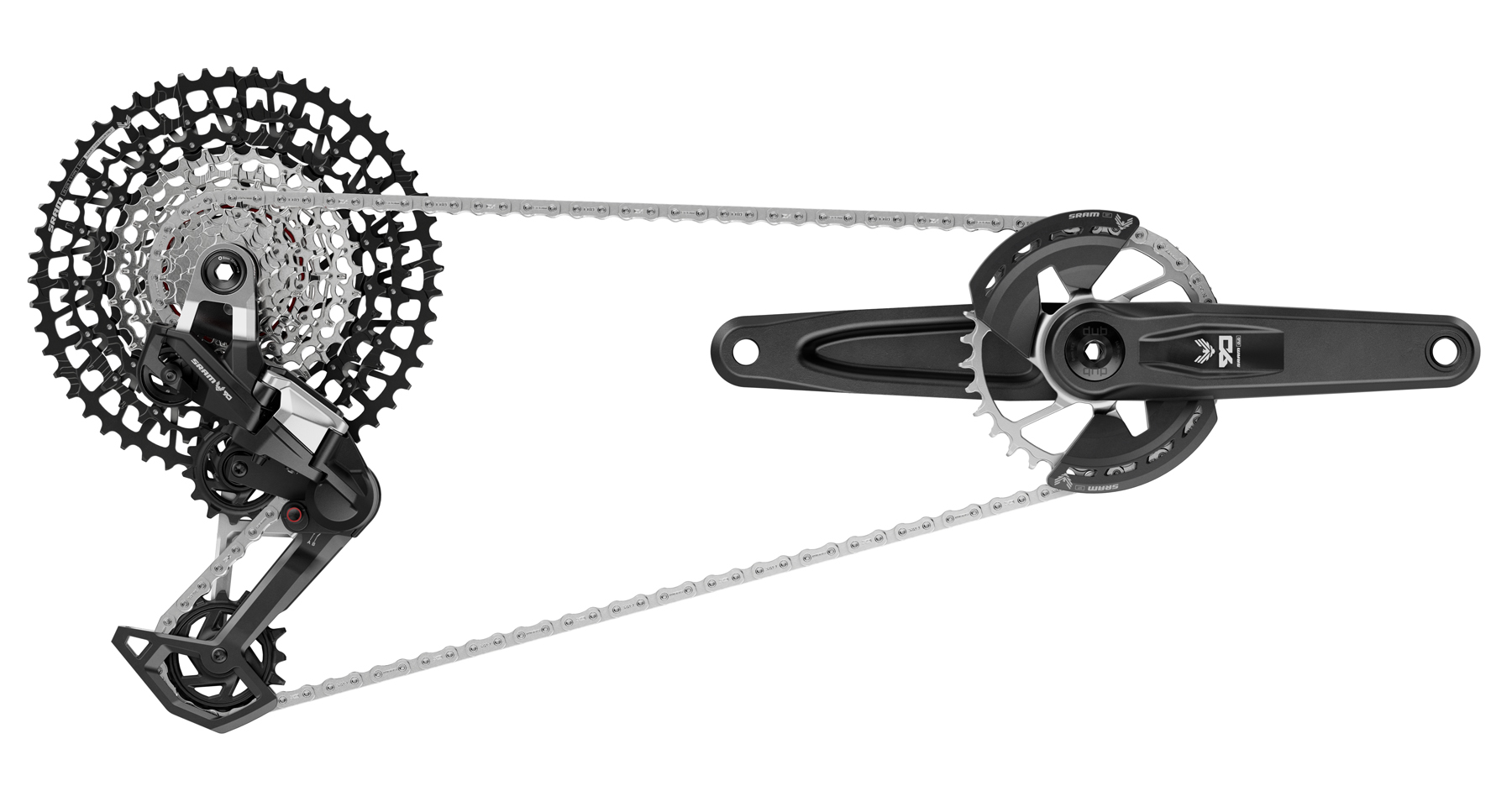
Eagle 70 Transmission is aimed primarily at OE sales on complete bikes, though the individual components are available as spares or if you want to piece a group together yourself. The Eagle 90 Transmission, on the other hand, is also offered as a full groupset with a range of options. The standard versions all include the dual-click shifter, derailleur, cassette, chain, and crank (w/ chainring and two bash guards); you’ll just need to add the appropriate bottom bracket for your bike. The eMTB groups are offered either with a crankset in Bosch or SRAM/Brose interfaces, or with a 104mm BCD chainring but no crank. There’s no ISIS crank-compatible groupset, so if you need that option, you’ll have to piece that together on your own. Pricing is as follows:
- Eagle 90 Groupset: $670 / €730 / £655
- Eagle 90 eMTB Groupset (w/ crank): $660 / €720 / £645
- Eagle 90 eMTB Groupset (104 mm BCD version w/o crank): $590 / €645 / £575
Dropper Post Lever
- MSRP: $40 / €45 / £40
- Stated Weight: 45 g
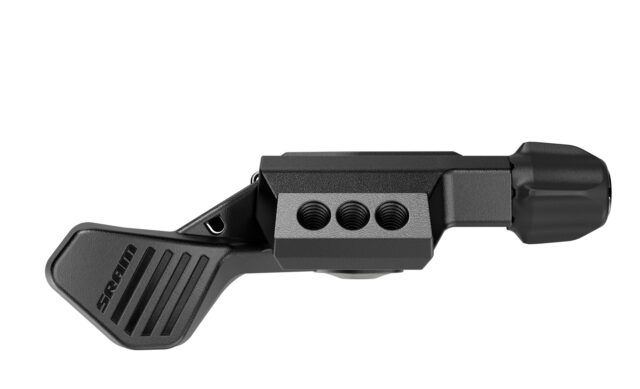

SRAM is also launching a lever for mechanical dropper posts, which routes the housing parallel to the handlebar for tidier aesthetics when paired with their Stealth brakes and the new mechanical T-Type shifters. SRAM, of course, hasn’t ever offered a cable-actuated seatpost, but it features 14 mm of cable pull, which makes it compatible with most cable-actuated droppers on the market. It clamps the cable at the lever end and is designed for SRAM’s Matchmaker X integrated clamps, with three bolt holes to offer some adjustability in its positioning.
Some Questions / Things We’re Curious About
(1) How do the new mechanical Transmission groups shift, and how durable are they?
(2) The electronic Transmission groupsets clearly prioritize shifting accuracy over speed if you’re running through more than a gear or two at a time. Does that also feel true of the mechanical variants, or are you able to shift across the whole cassette more quickly, given that there aren’t any electronics to regulate things?
(3) Will we see higher-end mechanical Transmission groups at a later date?
Bottom Line (For Now)
Mechanical versions of SRAM’s T-Type groupsets have been long rumored, and they’re now here, in two different tiers. We’ve already spent quite a bit of time on the Eagle 90 groupset, and BLISTER+ Members and folks with our Digital Access Pass can check out our impressions so far, and we’ll have a Full Review to follow.
Flash Review: Our Initial On-Trail Impressions
BLISTER+ members and those who purchase our Digital Access Pass can check out the Flash Review below to read our initial on-trail impressions. Get our Digital Access Pass to view all our Flash Reviews and Deep Dives, or become a BLISTER+ member today to get access to that and a LOT more, including the best worldwide Outdoor Injury Insurance, exclusive deals and discounts on skis, personalized gear recommendations from us, and much more.
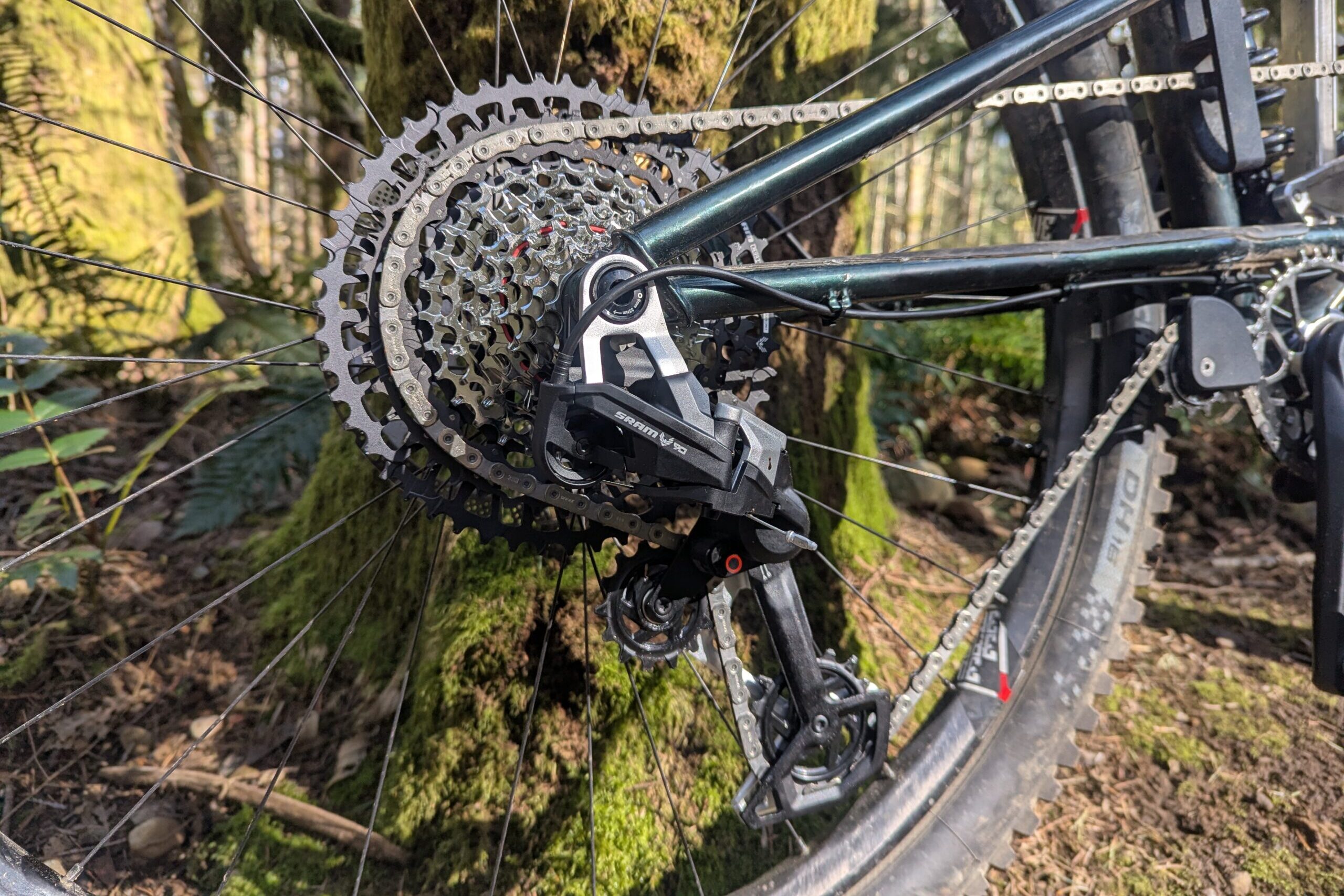
Flash Review: SRAM Eagle 90 Transmission
Mechanical SRAM Transmission is here. Check out our take on the Eagle 90 groupset so far.
Blister’s Flash Reviews and Deep Dives are accessible to those who purchase one of our paid subscriptions
To get our comprehensive Deep Dives and our initial, unfiltered reports on new gear, become a member and receive many other services, deals, and discounts.
If you’re already an active member, please log in.
(If you’re already logged in and a member in good standing and seeing this message in error, please refresh this page in your browser.)

So who is gonna combo the derailleur and shifter with a shimano hyperglide chain and cassette to theoretically get best of both worlds (by ditching the shimano mech that is made of cheese)? Might need a jockey wheels swap but should work otherwise?
Not saying it isn’t doable, but it’s trickier than that because the Transmission cassette is shifted outboard by 2.5 mm. Since there aren’t limit screws to make up for that offset, you’d need to figure out how to space the cassette outboard to match, at which point the 11th cog isn’t likely to mesh with the driver. (12th should be okay if 11th works, since it indexes off the 11th cog, not the driver directly.) You also might run into issues with the lockring rubbing on the derailleur, and/or needing a longer one to accommodate the spacer.
I did a quick measurement, and 11th gear won’t mesh with the driver at all if you space it out 2.5mm.
You might be able to get custom hub endcaps made to shift the whole hub over, but then you’d need to space the rotor back outboard so it lines up with the brake, and might still have clearance issues between the cassette lockring and the derailleur.
Damn, I should have guessed that would be the case. Well, thanks for checking!!
i’ve tested a sram eagle 70 ion my pivot sl. replaced the XT one due to it breaking. after 250miles….still shifts smoothly. can’t complain.